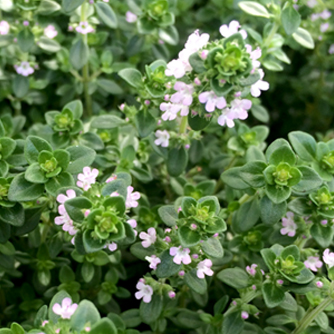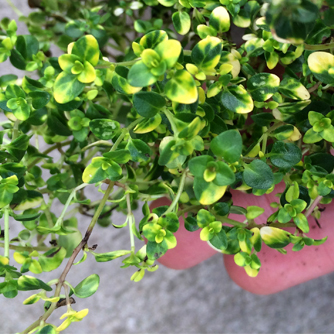Thyme
BackThyme is another great Mediterranean herb that is very fragrant and can take hot, dry conditions with lots of neglect. Thyme is used fresh or dried in soups, stews, herb bread and any recipe that requires mixed herbs. There are over 300 varieties of thyme and they make great ground covers, low border plants and even lawn substitutes. Try the lemon scented varieties placed between pavers to release a lovely smell when walked upon.
In Spring thyme rewards you with a mass of tiny flowers ranging in colours from white to pink to purple. The flowers are nectar rich and great for attracting bees and other beneficial insects. As such thyme is excellent planted in a corner of your veggie patch to improve pollination and increase natural predators. It is also perfect for those difficult dry spots in the garden where nothing else seems to grow.
Look out for the lovely ‘Silver Posie’ (grey and cream variegated foliage) or the ground hugging Thymus serpyllum ‘Magic Carpet’ which literally grows like a carpet and is a fantastic weed suppressant.

Regular culinary thyme
How to Grow
Thyme loves the heat and thrives in full sun but will tolerate some part shade as well. Thyme must have good drainage and can grow in most soil types including very poor sandy soils. The addition of some organic matter will help improve growth though. Thyme is not troubled by frost.
In areas with very wet and humid summers ensure plants are never waterlogged and that there is plenty of good airflow around them.
Most thymes are difficult to grow from seed with patchy germination. Instead buy young plants from the nursery or grow from division or cuttings in Spring and Summer.
Pruning and Fertilising
Thyme originates from areas with calcium rich alkaline soils and will appreciate an application of dolomite or lime once or twice a year. Otherwise they don’t need a lot of fertilising. Monthly applications of OCP eco-aminogro together with OCP eco-seaweed (particularly during Spring) will keep them happy and growing well.
Pruning is generally not needed but sometimes plants can get a bit tired and leggy. If this happens prune back quite hard and new growth will appear quickly.

Thyme in flower
Pest and Disease Problems of Thyme
Whitefly, mites, scale and aphids can sometimes trouble plants but can these be easily controlled with a horticultural oil spray.
Fungal problems on foliage, like powdery mildew, can develop in areas which have humid summers. Ensure good airflow around the plant and treat with an organic fungicide as required.
Various fungal root rot diseases can also attack if plants do not have good drainage. Only plant into well draining soils to prevent these problems occurring.

One of the unusual variegated thymes


